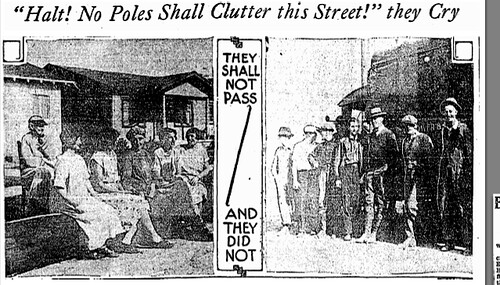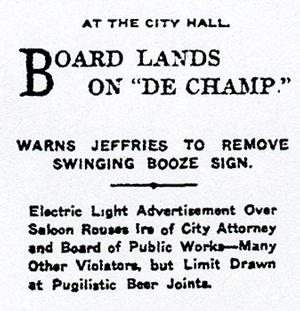
January 3, 1927
South Los Angeles
The men came marching onto County land, with their boots and their buckets and their shovels and their poles, and the ladies of East 71st Street, just east of Hooper Avenue, came out of their little bungalows, leaving their babies and their breakfast dishes and their washboards and their bougainvilleas, and they met there, in the middle of the road, and looked each other up and down.
"Why have you come to our little street?" asked the ladies.
"To install high tension electrical wires," the men replied.
"Down the middle of our street?"
"Down the middle of your street."
"Like hell you will!" was the ladies’ retort. And when the workmen returned to sink their poles on Monday morning, they found an angry mob of females who congregated around the various spots where holes were to be sunk and planted their bodies in the way of any work. One octogenarian brought a chair out and sat atop the digging spot, while others stood their ground and glared. At lunch time, other women came out and changed places, so no child would go without its meal.
The men retreated, not willing to spill female blood or risk their own safety further. On further investigation, it was revealed the city has not obtained the proper county permit to plant any such power line down 71st Street, so any such erection would be delayed indefinitely. And the next day, a spokesman for the work crew said, "They not only won, they routed us altogether. There’ll be six feet of ice at Sixth and Broadway before some of our men venture on Seventy-first street again. We ceased operations because we are not putting up any poles or lines on any street where the people object to them. Nothing will be done unless we can come to some agreement with the women."
Here’s to the heroines of the Battle of East 71st Street: Mrs. P. R. Bottomly of 1348 East 71st Street, Mrs. H. B. Dawson of #1332, Mrs. M. M. Schnell of #1342 and Mrs. W.J. Kline of #1315 and those who sat for the photograph (L-R): Mrs. Louisa H. Orr (aged 82), Mrs. W. A. Grubbs, Mrs. G. S. McIntyre (provisional general), Mrs. M. Robertson (aide-de-camp), Mrs. R. Jackson (chief of staff) and Mrs. Louise Dixson. For sisterhood is powerful, NIMBYism is nothing new in Los Angeles, and who the hell wants power lines cluttering up their view?




 Here’s a vision of the future: electric signage along Broadway, ca. 1920, as pictured in, uh,
Here’s a vision of the future: electric signage along Broadway, ca. 1920, as pictured in, uh,